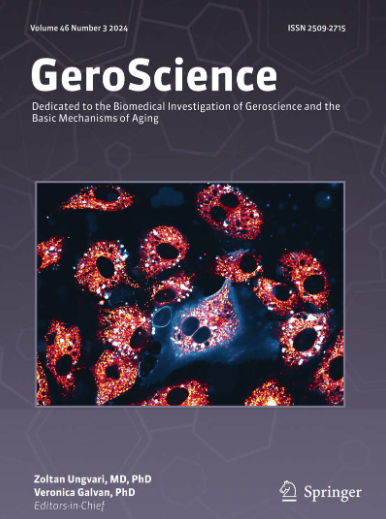Neuroprotective mechanism of hydrogen sulfide in okadaic acid-induced alzheimer-like pathology.
IF 5.3
2区 医学
Q1 GERIATRICS & GERONTOLOGY
引用次数: 0
Abstract
Okadaic acid (OKA) is a marine biotoxin that accumulates in shellfish and is responsible for causing diarrheic shellfish poisoning. OKA is a powerful and selective inhibitor of serine/threonine phosphatases 1 and 2A, which induces hyperphosphorylation of tau in vitro and in vivo leading to Alzheimer's disease (AD)-like pathology and memory impairment. Hydrogen sulfide (H2S), a gaseous signaling molecule produced endogenously in the brain, has been demonstrated to possess neuroprotective properties in various models of neurodegeneration. The aim of this study was to investigate the potential of H₂S in reducing OKA-induced Alzheimer's disease (AD)-like pathology, focusing on its effects on the GSK3β/Tau and CaMKII/CREB signaling pathways in mice. To test this hypothesis, we used age 8-10 weeks-old male C57BL/6J wild-type mice, divided into the following experimental groups: 1. Control group: Received a single intracerebroventricular (ICV) injection of artificial cerebrospinal fluid (aCSF). 2. WT + OKA group: Received a single ICV injection of OKA (100 ng/5 µl) bilaterally to induce AD-like pathology. OKA was dissolved in artificial cerebrospinal fluid. 3. WT + OKA + GYY4137 group: Received a single ICV injection of OKA (100 ng/5 µl) bilaterally, followed by GYY4137 (30 µM/kg) via drinking water for 21 days. 4. WT + GYY4137 group: Received only GYY4137 per se (30 µM/kg) via drinking water for 21 days. After the treatment period, synaptic proteins and neurodegeneration were evaluated using Western blotting, RT-PCR, and immunohistochemistry techniques. Our results demonstrate that OKA administration results in memory impairment with decreased cerebral blood flow (CBF). OKA also caused a significant decrease in synapse proteins (PSD95, MAP-2, BDNF, CaMKIIα, and Tubulin-3β) levels, along with increased expression of Tau, PHF-1, and GSK-3β and memory-associated signaling molecules and pCREB. Interestingly, IP administration of GYY4137 (30 µM/Kg; an H2S donor) for 21 days significantly improved the level of synapse proteins and memory function in OKA-treated mice. The findings of this study determine the neuroprotective mechanism of H2S in OKA-induced AD-like pathology through the modulation of Tau, GSK3β, and pCREB signaling. Therefore, H2S ameliorates OKA-induced memory impairment by improving synapse function and forgetfulness. As a result, H2S could be used as a promising therapeutic molecule against Alzheimer's disease-like pathology.硫化氢在冈田酸诱导的阿尔茨海默样病理中的神经保护机制。
冈田酸(OKA)是一种海洋生物毒素,可在贝类体内积累,引起腹泻性贝类中毒。OKA是一种强大的选择性丝氨酸/苏氨酸磷酸酶1和2A抑制剂,在体外和体内诱导tau过度磷酸化,导致阿尔茨海默病(AD)样病理和记忆障碍。硫化氢(H2S)是大脑内源性产生的一种气体信号分子,已被证明在各种神经退行性疾病模型中具有神经保护作用。本研究的目的是探讨h2s在减少oka诱导的阿尔茨海默病(AD)样病理中的潜力,重点关注其对小鼠GSK3β/Tau和CaMKII/CREB信号通路的影响。为了验证这一假设,我们选用8-10周龄雄性C57BL/6J野生型小鼠,分为以下实验组:对照组:单次脑室注射人工脑脊液(aCSF)。2. WT + OKA组:双侧单次ICV注射OKA (100 ng/5µl)诱导ad样病理。OKA溶解于人工脑脊液中。3. WT + OKA + GYY4137组:双侧单次ICV注射OKA (100 ng/5µl),随后饮水注射GYY4137(30µM/kg),持续21天。4. WT + GYY4137组:仅通过饮用水接受GYY4137本身(30µM/kg),持续21天。治疗期后,采用Western blotting、RT-PCR和免疫组织化学技术评估突触蛋白和神经变性。我们的研究结果表明,服用OKA会导致记忆障碍和脑血流量(CBF)的减少。OKA还导致突触蛋白(PSD95、MAP-2、BDNF、CaMKIIα和Tubulin-3β)水平显著降低,Tau、PHF-1、GSK-3β和记忆相关信号分子和pCREB的表达增加。有趣的是,GYY4137的IP给药(30µM/Kg;(H2S供体)持续21天,显著提高了oka处理小鼠的突触蛋白水平和记忆功能。本研究的结果确定了H2S通过调节Tau、GSK3β和pCREB信号传导在oka诱导的ad样病理中的神经保护机制。因此,H2S通过改善突触功能和健忘来改善oka诱导的记忆障碍。因此,H2S可以作为治疗阿尔茨海默病样病理的有前途的治疗分子。
本文章由计算机程序翻译,如有差异,请以英文原文为准。
求助全文
约1分钟内获得全文
求助全文
来源期刊

GeroScience
Medicine-Complementary and Alternative Medicine
CiteScore
10.50
自引率
5.40%
发文量
182
期刊介绍:
GeroScience is a bi-monthly, international, peer-reviewed journal that publishes articles related to research in the biology of aging and research on biomedical applications that impact aging. The scope of articles to be considered include evolutionary biology, biophysics, genetics, genomics, proteomics, molecular biology, cell biology, biochemistry, endocrinology, immunology, physiology, pharmacology, neuroscience, and psychology.
 求助内容:
求助内容: 应助结果提醒方式:
应助结果提醒方式:


